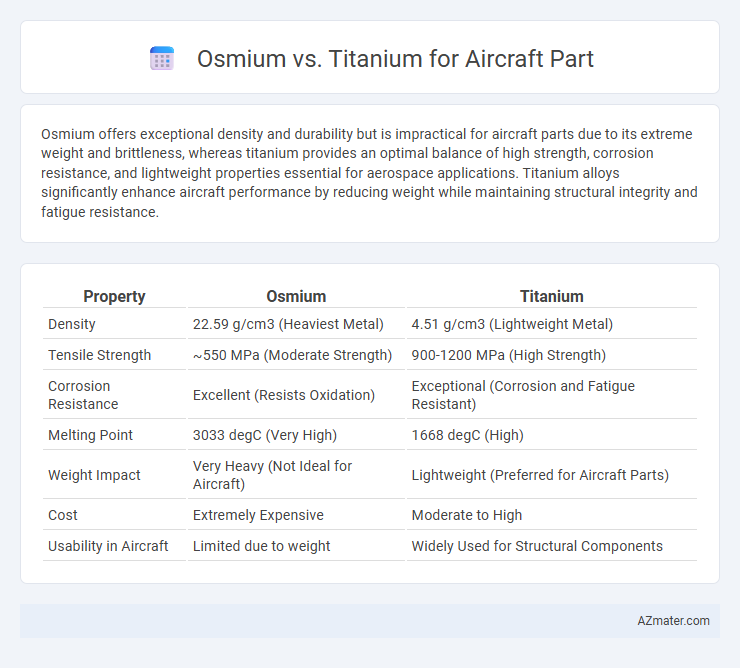Osmium offers exceptional density and durability but is impractical for aircraft parts due to its extreme weight and brittleness, whereas titanium provides an optimal balance of high strength, corrosion resistance, and lightweight properties essential for aerospace applications. Titanium alloys significantly enhance aircraft performance by reducing weight while maintaining structural integrity and fatigue resistance.
Table of Comparison
| Property | Osmium | Titanium |
|---|---|---|
| Density | 22.59 g/cm3 (Heaviest Metal) | 4.51 g/cm3 (Lightweight Metal) |
| Tensile Strength | ~550 MPa (Moderate Strength) | 900-1200 MPa (High Strength) |
| Corrosion Resistance | Excellent (Resists Oxidation) | Exceptional (Corrosion and Fatigue Resistant) |
| Melting Point | 3033 degC (Very High) | 1668 degC (High) |
| Weight Impact | Very Heavy (Not Ideal for Aircraft) | Lightweight (Preferred for Aircraft Parts) |
| Cost | Extremely Expensive | Moderate to High |
| Usability in Aircraft | Limited due to weight | Widely Used for Structural Components |
Introduction to Osmium and Titanium in Aerospace
Osmium, one of the densest and heaviest metals, offers exceptional hardness and corrosion resistance, making it suitable for specialized aerospace components demanding durability and stability under extreme conditions. Titanium, widely used in aircraft manufacturing, is renowned for its high strength-to-weight ratio, excellent corrosion resistance, and ability to withstand high temperatures, optimizing fuel efficiency and structural integrity. Both metals contribute unique advantages in aerospace applications, with titanium dominating lightweight structural parts and osmium applied in niche areas requiring extreme hardness and wear resistance.
Material Properties Overview: Osmium vs Titanium
Osmium exhibits exceptional density and hardness, making it one of the heaviest and most wear-resistant metals, but its brittleness and high cost limit its use in aircraft parts. Titanium combines high strength-to-weight ratio, corrosion resistance, and excellent fatigue performance, making it the preferred choice in aerospace applications. The lightweight characteristic and durability of titanium outperform osmium's density, allowing for more efficient and safer aircraft components.
Strength and Durability Comparison
Osmium exhibits exceptional density and hardness, making it highly resistant to wear and deformation, which offers superior durability in harsh aerospace environments. Titanium, known for its high strength-to-weight ratio and excellent corrosion resistance, provides substantial structural integrity while significantly reducing overall aircraft weight. The combination of titanium's lightweight properties and osmium's hardness allows aerospace engineers to optimize aircraft parts for both strength and long-term durability.
Weight Considerations in Aircraft Design
Osmium and titanium differ significantly in weight considerations for aircraft design, with osmium being one of the densest elements at 22.59 g/cm3, while titanium has a much lower density of approximately 4.51 g/cm3. The high density of osmium would drastically increase the aircraft's weight, adversely affecting fuel efficiency and overall performance. Titanium's combination of low density and high strength-to-weight ratio makes it the preferred choice for aircraft parts where weight reduction and durability are critical.
Corrosion Resistance Under Aviation Conditions
Osmium exhibits exceptional corrosion resistance due to its dense atomic structure and high oxidative stability, making it highly resilient under harsh aviation conditions. Titanium also demonstrates outstanding corrosion resistance, particularly against saltwater and atmospheric exposure, thanks to its self-passivating oxide layer, which effectively protects aircraft parts from oxidation and fatigue. While osmium offers superior chemical inertness, titanium's lighter weight and proven durability make it the preferred material for most corrosion-resistant aircraft components.
Cost Analysis: Osmium vs Titanium
Osmium, one of the densest and rarest metals, carries an extremely high cost per kilogram, making it economically impractical for widespread aircraft part production. Titanium, known for its excellent strength-to-weight ratio and corrosion resistance, offers a more cost-effective solution with prices significantly lower than osmium, facilitating its extensive use in aerospace manufacturing. The substantial cost difference and availability favor titanium over osmium for aircraft components when balancing budget constraints and material performance.
Machinability and Fabrication Challenges
Osmium's extreme hardness and high density significantly limit its machinability, making it unsuitable for aircraft parts requiring complex fabrication or precision. In contrast, titanium offers excellent machinability combined with superior strength-to-weight ratio, enabling easier shaping and welding essential for aerospace applications. Fabrication challenges with osmium include brittleness and toxicity concerns, whereas titanium's corrosion resistance and ductility streamline manufacturing processes in aircraft component production.
Safety and Toxicity Concerns
Osmium, known for its extreme density and hardness, poses significant safety and toxicity concerns in aircraft parts due to its toxic osmium tetroxide emissions when oxidized, which can cause severe respiratory issues. Titanium offers a safer alternative with excellent strength-to-weight ratio, corrosion resistance, and biocompatibility, minimizing health risks during manufacturing and operational use. The aerospace industry favors titanium for critical components to ensure crew safety and compliance with stringent toxicity regulations.
Real-world Applications and Case Studies
Osmium and titanium each offer distinct advantages for aircraft parts, with titanium widely favored for its exceptional strength-to-weight ratio, corrosion resistance, and proven use in airframes, engine components, and landing gear in major commercial aircraft like the Boeing 787 Dreamliner. Osmium, with its extreme density and hardness, remains less common but has potential in specialized applications such as wear-resistant coatings and high-precision instruments, demonstrated in aerospace niche sectors where durability under extreme conditions is critical. Case studies highlight titanium's ability to reduce weight and improve fuel efficiency, while osmium's limited real-world use reflects challenges in machining and cost, positioning titanium as the dominant material in mainstream aircraft manufacturing.
Future Prospects for Osmium and Titanium in Aviation
Osmium's extreme density and hardness offer potential for highly durable aircraft components designed to withstand intense mechanical stress and heat, making it a candidate for specialized high-performance parts in future aviation technology. Titanium's strength-to-weight ratio, corrosion resistance, and ability to maintain structural integrity at high temperatures ensure its continued dominance in aircraft frames, engine components, and fasteners as aviation pushes toward more efficient and lightweight designs. Ongoing research into alloy development and additive manufacturing techniques is expected to enhance the performance characteristics of both osmium and titanium, driving innovation in the aerospace industry's pursuit of safer, lighter, and more resilient aircraft structures.

Infographic: Osmium vs Titanium for Aircraft Part
 azmater.com
azmater.com